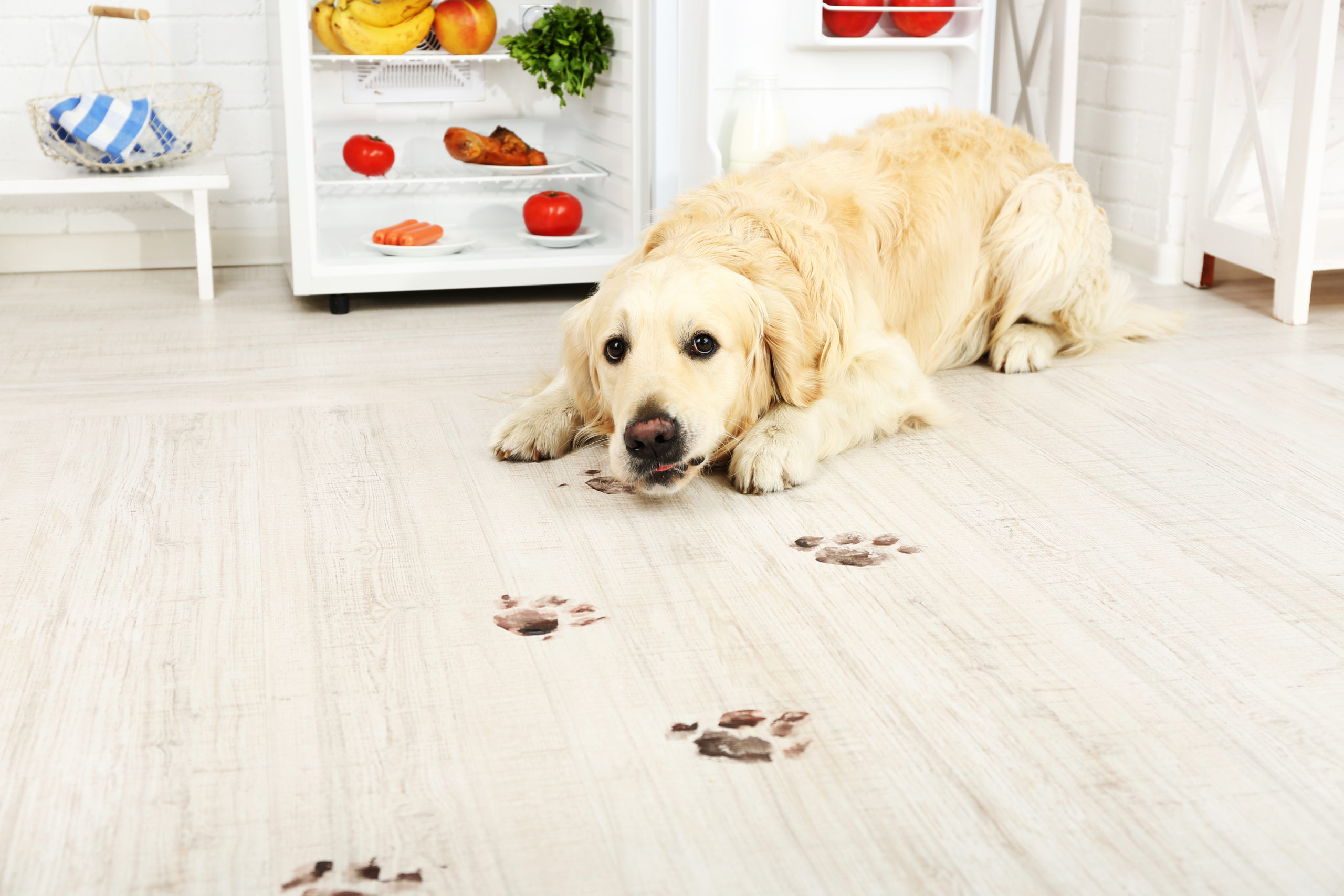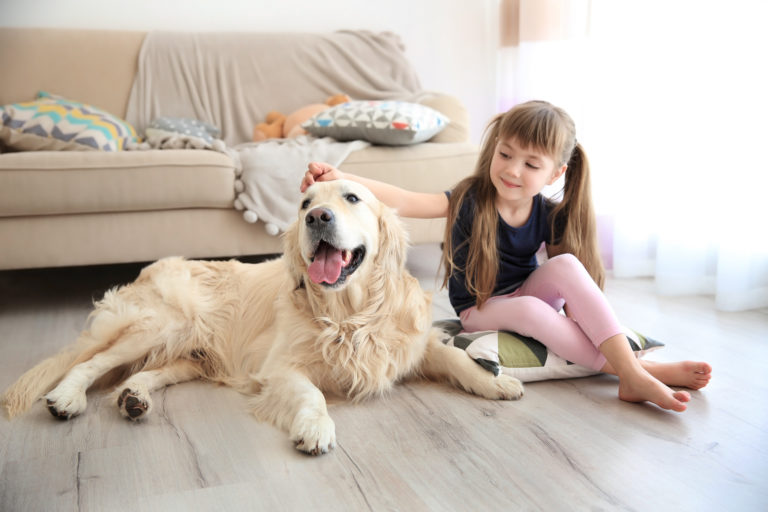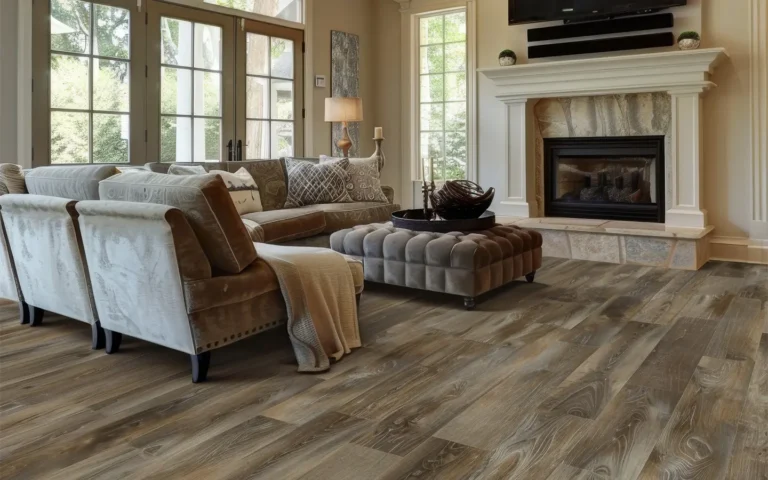This post may contain references or links to products from one or more partners of our parent company and/or subsidiaries of our parent company. For more information, visit this page.
Updated February 14, 2022
If you’re making some home improvements and looking for the best flooring for dogs, we can relate. We’ve been there too!
There are so many types of flooring out there to choose from; how can you know what will hold up well with dogs and other pets?
Whether you’re flooring one room or your entire house, your pets—especially dogs—are a giant consideration. You’re likely wondering if certain types of wood flooring will hold up better than others, if you’d do better with carpet or hardwood, or if there are other flooring ideas you need to consider.
The short answer: it’s complicated.
That’s why below, we’re going to go over 7 flooring materials that have a claim to the best flooring for pets trophy. We’ll explain—in detail—how they work, their advantages and disadvantages, and why each one might be the best flooring for dogs.
We’ll even talk about the few options you really should stay away from, best practices in caring for your pet-friendly flooring, and answer a few of the most frequently asked questions about buying waterproof flooring for pets. Consider it your cheat sheet!
The Best Flooring for Dogs and Other Pets: An Overview
Life is full of trade-offs: you want the joy of children, you need to reign in your free-ranging lifestyle; you want a rockin’ beach bod, you have to give up your Oreo obsession. You want a furry companion, kiss your dream floors goodbye. Right?
Wrong! You can still have a beautiful home with pets (well, beautiful floors, at least—we can’t guarantee your furniture). You just need to install the right kind of floor.
Luckily, with a bit of research and planning, you can find great flooring for pets that will coexist peacefully with your fur baby.
The 7 types of flooring we’ll cover are:
- Vinyl Plank
- Tile
- Laminate
- Bamboo
- Cork
- Concrete
- Engineered Hardwood (specifically water-resistant wood flooring varieties)
#1: Vinyl Plank—Perhaps the Best Waterproof Flooring for Pets
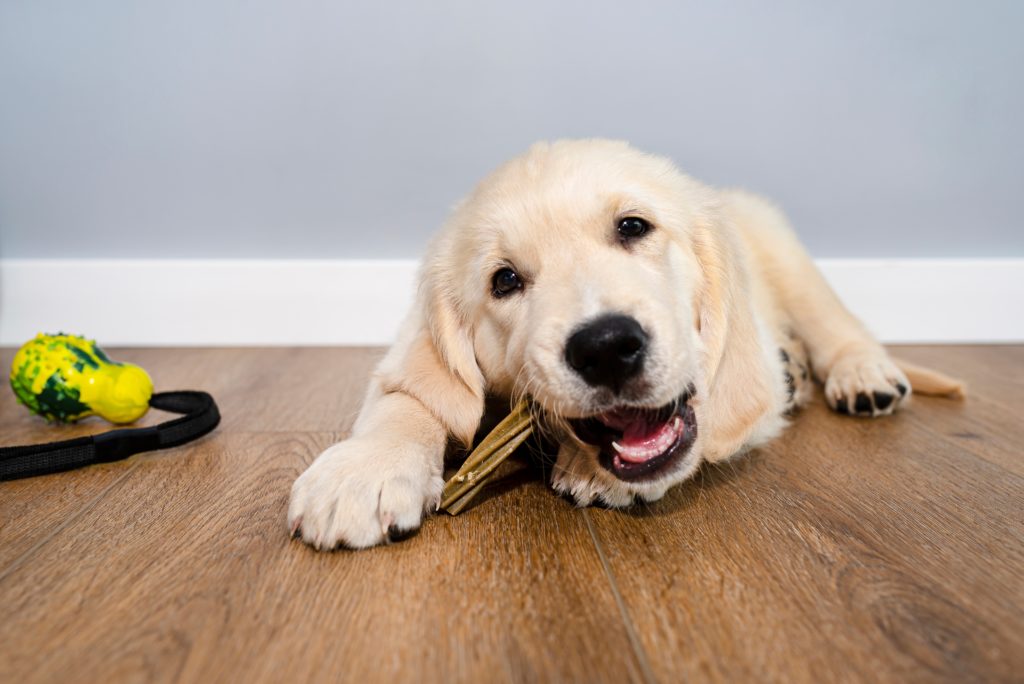
Vinyl is some of the best waterproof flooring for dogs—and pets—in general. Why? Because all vinyl flooring is waterproof vinyl flooring! The material is impervious to moisture by default.
An important distinction here: when we’re talking about vinyl plank flooring, we’re talking about something commonly known as LVP (aka luxury vinyl plank) or LVT (luxury vinyl tile).
We’re not talking about the vinyl sheet in your grandma’s guest bathroom. That material is waterproof as well, but it’s much softer than vinyl plank—meaning it can get ripped up by pet claws.
Vinyl plank, also known as PVC flooring, is made of plastic. So even though the best vinyl plank flooring looks exactly like wood (or in the case of LVT, like tile), vinyl is completely synthetic. And since it comes in planks (just like real wood), you can use it to create wood floor patterns (aka parquet flooring).
Which Vinyl Plank Floor Variety is Best for Pets?
If you look through the best vinyl plank flooring brands, you’ll find each floor’s core layer is an essential factor to consider.
You’ll find flexible vinyl plank flooring, EVP (engineered vinyl plank) flooring, and a whole lot more. The important thing to remember: rigid core luxury vinyl flooring is generally more durable than flexible core luxury vinyl flooring. And that generally makes it better flooring for dogs.
Additionally, there are many different types of rigid vinyl plank floors—SPC flooring and WPC flooring being the most popular.
Note: While SPC is more dent-resistant, dogs tend to prefer WPC because it’s a bit softer.
Why Vinyl Plank Might Be the Best Flooring for Dogs
Vinyl has an awful lot to offer to families with pets. First, it’s super affordable. Second, it’s incredibly sturdy—even the most active dogs will have difficulty scratching it up.
And not only is it excellent for dog owners, but vinyl flooring is also excellent for dogs themselves! As we mentioned, certain types of vinyl (like COREtec flooring, a popular WPC brand) are super comfortable for dogs to walk on—which is ideal for aging joints.
And for your older pup, you can also find skid-resistant vinyl flooring, which can be great for helping them stay on their feet when they’re not quite as young and spry as they once were.
Vinyl flooring is also effortless to clean and maintain. So if your dog has the occasional accident, you don’t need to worry about your vinyl floor getting ruined (like we said, it’s some of the best waterproof flooring for pets).
Will a Dog Scratch Up My Vinyl Floor?
As long as you’re looking for the best vinyl plank flooring and not the best vinyl sheet flooring, you won’t have a problem. Most LVP (excluding budget brands like Stainmaster luxury vinyl or Lumber Liquidators’ CoreLuxe) is super scratch-resistant.
Your floor won’t suffer from denting, scuffing, or scratching, no matter how hard your pooch tries—it’s that durable. If you’re concerned about your fashion-forward flooring (like Doma) being ruined, you can rest easy!
Will Dog Urine Ruin My Vinyl Plank?
If you properly install your vinyl flooring, you have nothing to worry about. Vinyl plank is frequently installed as a floating floor, which is good news for dog accidents. Because the planks are so tightly locked together, urine can’t get through the spaces in between and ruin your subfloor. And that’s typically your biggest worry.
Side note: we’ll talk a good deal about subfloors in this piece. And if that’s got you wondering what is subflooring?, it’s just the material beneath your actual floor (usually made of plywood or concrete).
How Do You Install Vinyl Plank Flooring?
LVP is relatively easy to install, meaning the cost to install vinyl plank flooring is very appealing. You have multiple options, so you can go with whichever sounds easiest to you and whichever will best suit your needs.
Basically, there are two main methods:
- Glue-down vinyl plank flooring (which is exactly what it sounds like).
- Floating vinyl plank flooring (which is a little more complicated).
What is a floating floor? It’s a floor that isn’t attached to the surface below it. And there are two main types of floating vinyl floors:
- Loose lay vinyl plank flooring (which relies on its weight and rubber backings to stay in place).
- Click-lock vinyl plank flooring.
Click-lock (or “click-together”) flooring is by far the most common type of LVP installation. This method uses special grooves in the side of each plank to join the floor together, creating a seamless (and more waterproof) surface.
Are there some disadvantages of floating floors? Yes—but almost all of them can be solved by using a proper underlayment for vinyl flooring rather than putting them directly atop the subfloor.
Note: peel and stick vinyl plank flooring isn’t generally the best flooring for dogs. It’s more of a temporary fix and won’t stand up to running puppies for long.
Why Vinyl Might Not Be the Best Flooring for Pets
There aren’t a lot of disadvantages of vinyl plank flooring when it comes to your pets. Most of its downsides fall outside of the pet realm.
For example, even the best vinyl plank flooring may not drastically improve your home’s resale value as much as hardwood.
Low-quality vinyl floors can dull or warp, with or without pets. If you opt for a plank with a thick wear layer and avoid mediocre products like NuCore flooring, however, you’ll find LVP a solidly waterproof floor for pets.
And finally, the patient zero when it comes to problems with luxury vinyl tile: it’s not super environmentally friendly, seeing how it’s made of plastic. There are low-VOC vinyl flooring brands out there—Proximity Mills, for example—but you need to search them out.
Best Brands of 2024
#2: Engineered Hardwood—The Only Type of Wood Flooring for Dogs
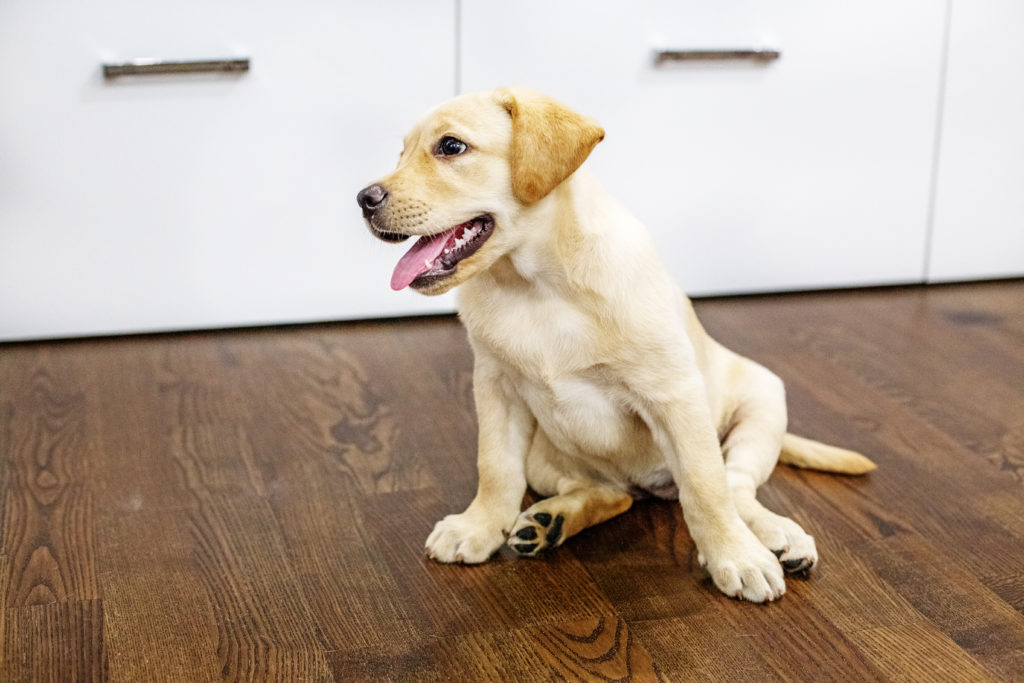
If you have your heart set on buying hardwood floors, make sure they’re engineered rather than solid.
Let’s get this out of the way: engineered hardwood is not fake wood flooring. It is 100% real wood and is one of the most durable wood flooring options you can find. So then, what is engineered hardwood, exactly?
Engineered hardwood planks are made of 2 layers: a hardwood veneer on top of a layer of high-performance plywood. This differs from solid hardwood planks, which are precisely that—solid hardwood all the way through.
Solid wood is prone to warping and bending when it gets wet; engineered wood is less so.
Additionally, engineered wood almost always comes as prefinished hardwood flooring. This is very important, as prefinished wood floors are much more durable than finished-on-site wood floors (there are several UV curing practices that can only be done in a factory).
Finally (and this is very important) all waterproof hardwood flooring options are made of engineered wood. It’s waterproof like vinyl, but more durable than laminate— and if you want the best flooring for dogs, you’re going to want something waterproof.
And if it isn’t waterproof, it had better be durable to stand up to your dog’s claws (or teeth… but hopefully not teeth). In that case, you’ll want high-density hardwood flooring—it’s designed to stand up prevent compression, which is the true enemy of hardwood.
Very few companies offer waterproof hardwood—Raintree and Hydrotek have some of our favorite products. But it’s even rarer that a company offers waterproof and high-density options; so if you’re looking for a company that offers both, check out Proximity Mills!
Why Engineered Hardwood Might Be the Best Flooring for Dogs
The best engineered wood flooring can be remarkably scratch-resistant if it’s factory-finished.
In addition, wood varies in its hardness level, so you’ll want a surface like ebony flooring or teak flooring, as opposed to a soft surface like pine flooring or Douglas fir flooring. Many of the best engineered wood flooring brands offer all sorts of hardwood species, so you shouldn’t have any trouble finding something that works for you.
All of that to say: the best wood flooring for dogs is always going to be engineered.
How Do You Install Engineered Hardwood?
The cost to install engineered hardwood floors is higher than for some of the other floors on this list—but it’s still less expensive than installing solid hardwood.
Why Engineered Hardwood Might Not Be the Best Flooring for Pets
Let’s be clear about the engineered wood disadvantages when it comes to owning pets: unless you buy a waterproof product, you’re going to have issues. And unless you go with a super durable hardwood species (and a factory finish), you’re going to have scratching issues. That’s just the nature of the best—and the reason wood doesn’t usually show up on best flooring for dogs lists.
#3: Tile—A Traditional and Beautiful Floor for Pets
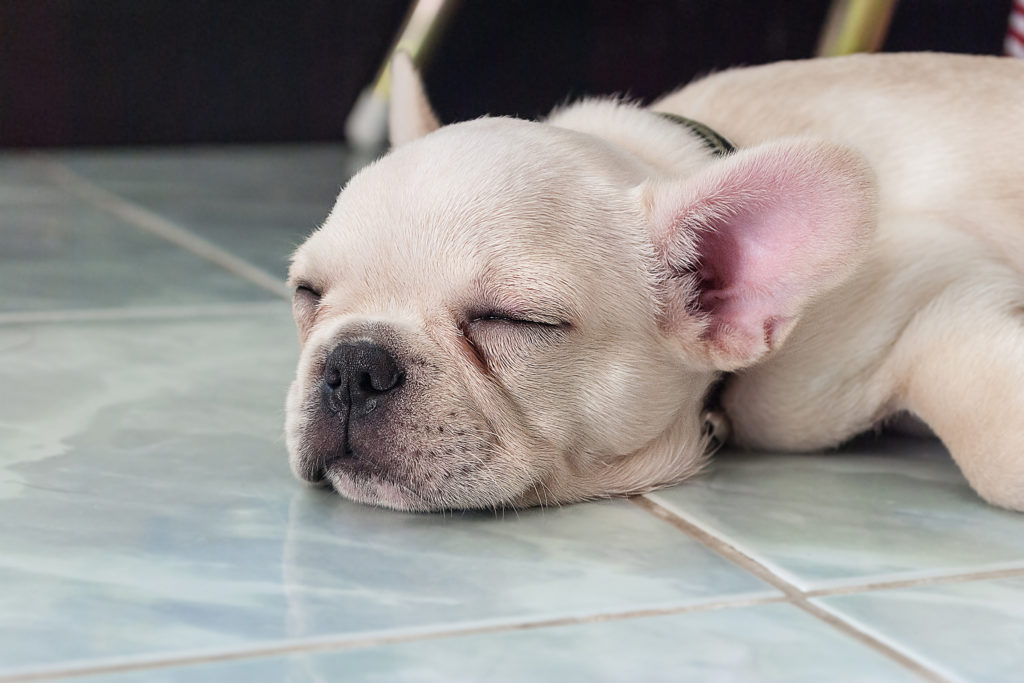
Surely you’re familiar with the basic concept of tile—small squares made of porcelain, ceramic, or stone, with grout in between. You’ve seen tile used in thousands of bathrooms, as sunroom flooring, in kitchens, etc.
Did you know, though, how many different types of tile there really are? Ceramic, cement, glazed vs. unglazed, the list goes on; you can even find wood-look tile to scratch that wood flooring itch!
Why Tile Might Be the Best Flooring for Dogs
Tile is ultra-durable. This is one floor that can take a beating and last a very long time. In fact, they’re still finding perfectly preserved tile floors from thousands of years ago all over Europe and Asia.
Tile is scratch-resistant because it’s so dang hard. Your dog can run back and forth on it all day long without leaving a single mark.
It’s also incredibly easy to clean up in the event of accidents or spilled water dishes. Because tile is waterproof, all you need to do is wipe up any puddles. A regular sweep and some occasional mopping will keep this flooring in top shape. That’s why it’s in so many bathrooms! Talk about waterproof flooring for pets!
Another bonus? Tile doesn’t stain. So even if you can’t clean up a pet accident immediately, you don’t need to worry about discoloration. Grout, though, may be a different story…
How Do You Install Tile Flooring?
Here’s the big downside: tile isn’t very easy to install. A lot of work goes into it, including a good amount of prep ahead of time.
To begin with, you need a suitable subfloor. If your subfloor isn’t in great shape, you risk laying the tile unevenly. This could be disastrous, as the uneven spacing could cause cracking. And if your subfloor is plywood, you’ll need to add an underlayment (since tile can’t go right on top of plywood).
When you’re ready to begin tiling, it’s best to start from the center of the room and work outward from there. First, you need to space the tiles and leave room for grout, ensuring at the same time that the tiles are straight. Next, you adhere the tiles to the subfloor, and once they are dry, add the grout in between.
All of that to say: the easiest way to install a tile floor is to hire a professional from a flooring store in your area. Of course, this will increase your installation costs… but it will also save you from having to put all of your money into the swear jar. So you might just break even in the end.
Looking to avoid a lot of hassle? You could try snap-together tile flooring. Just as with snap-together vinyl flooring, you can pop these pieces together and create a floating floor.
Why Tile Might Not Be the Best Flooring for Pets
While tile is some of the best waterproof flooring for pets, there are some downsides to this material.
Most notably, the outstanding hardness that keeps your tile floor scratch-free can backfire on your pup. Its hardness can make it uncomfortable for dogs to lay, or even walk on. Tile is also a very slippery surface, so dog paws may have a difficult time finding traction.
All of that to say: it might not be the best flooring for dogs with bad joints or the best flooring for pets in their later years.
Click, click, click. Oh, yeah, tile is loud, too. You’ll definitely hear the pitter-patter of doggie nails on your tile floor.
Tile is also notoriously cold. While you can wear slippers to protect your tootsies, your dog doesn’t have that luxury. Washable throw rugs and a cushiony dog bed may help alleviate some of these problems, but if you’re looking for the best flooring for dogs of a certain age… well, low-VOC carpet might be a better way to go.
You can also check out radiant heating, which works similarly to heating a wood floor.
#4: Laminate—Surprisingly Offering Some of the Best Flooring for Dogs
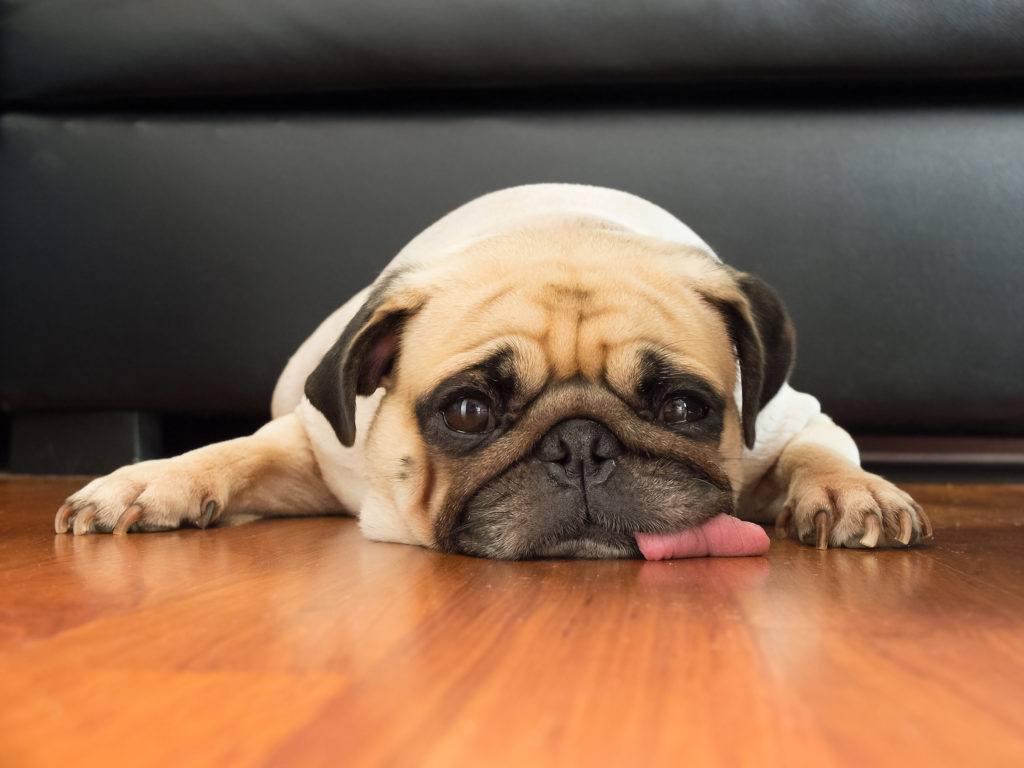
You’ve heard of laminate flooring millions of times and have probably walked over a million times more. But what is laminate flooring? Isn’t it the same thing as vinyl?
In a word: no.
Laminate flooring is a hardwood floor alternative (like vinyl), but it’s not made of plastic. Rather, it’s made of an HDF base, a hyper-realistic image layer, and a super-durable transparent wear layer.
These layers are then pressed together at a high temperature to make a durable and extremely scratch-resistant surface. The best laminate flooring is indistinguishable from hardwood flooring and can come in a wide variety of wood floor colors and looks.
So why is it surprising that laminate products offer some of the best flooring for dogs? Because traditional laminates are extremely vulnerable to moisture. These days, though, waterproof laminate flooring has changed the game.
Why Laminate Might Be the Best Flooring for Dogs
Laminate flooring is a great way to get that wood look floor for less. It can be pretty affordable and looks great.
Best of all: the best laminate flooring brands are extremely scratch-resistant—as in, often equally (or more) scratch-resistant than LVP.
Laminate is also very difficult to stain and very simple to clean—all necessary traits if you want the best flooring for dogs.
Which Laminate Product Offers the Best Flooring for Pets?
Because the bottom laminate flooring layers are sensitive to moisture, waterproof laminate is the best laminate flooring for dogs.
Who makes waterproof laminates? More companies than you might think! While Mohawk’s RevWood is perhaps the most popular, Newton and Floor & Decor’s AquaGuard flooring is also a fantastic option. A line of Shaw laminate flooring called Repel is also well-reviewed, and Pergo TimberCraft reviews aren’t bad either.
Again: you only want waterproof options if you’re looking for the best flooring for pets, so steer clear of budget brands like TrafficMaster flooring (a Home Depot exclusive) or the various lines of Costco laminate flooring you see while bulk-buying ranch dressing and Doritos.
How Do You Install Laminate?
Laminate flooring can be installed in the exact same way as vinyl flooring, though you can also staple laminate down. To that end, the cost to install laminate flooring is almost the same as it is for vinyl.
Why Laminate Might Not Be the Best Flooring for Pets
Even if you buy from the best laminate flooring brands, you’re inviting disaster if you buy a non-waterproof laminate floor. The best flooring for dogs simply has to be waterproof.
Additionally, the protective coating that makes laminate scratch resistant can also make it slippery. Your dog may have a difficult time moving easily on laminate floors, so the trade-off may not be worth it. You can, however, try a textured type of laminate so that your dog can get some traction.
Finally, as with any other composite, laminate isn’t always the most eco-friendly flooring choice. Some products like Armstrong laminate flooring aren’t even sold in the US anymore because of chemical issues—so be sure to shop for non-toxic laminate flooring only.
#5: Bamboo—Very Strong and Environmentally Friendly
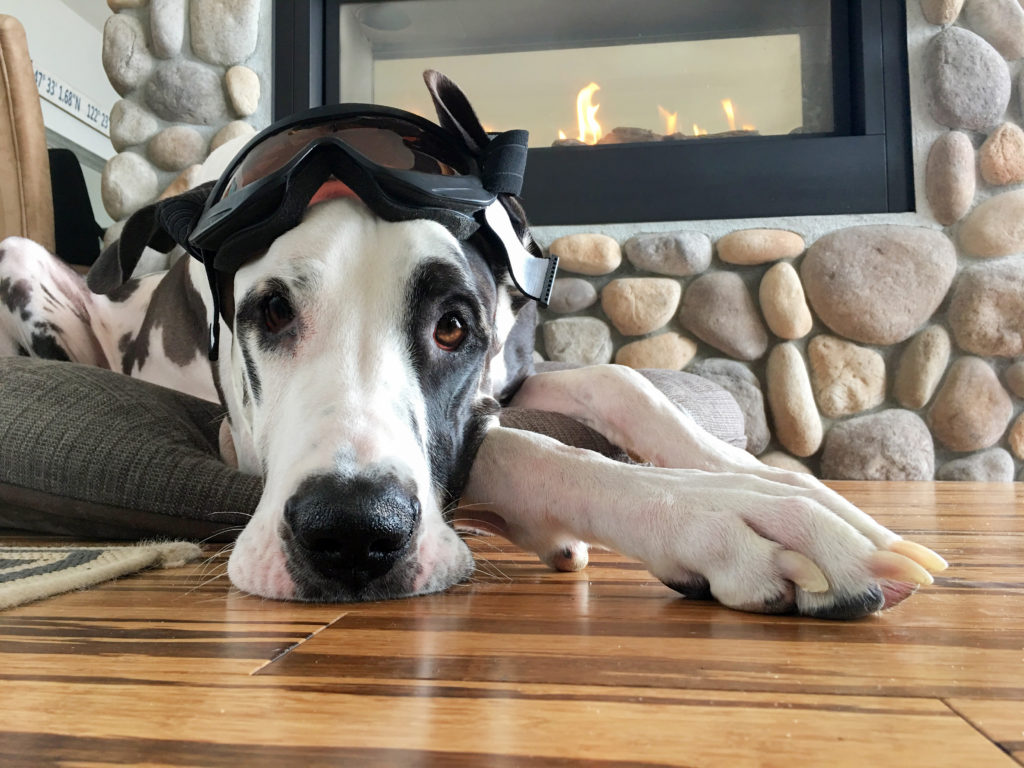
Does your dog like to eat grass when you’re not looking? Well, now it can sleep on it too! Bamboo strongly resembles hardwood, but it’s technically part of the grass family—and it makes for some of the best flooring for dogs.
Why? Bamboo is not nearly as fragile as you might think. You can stain and even refinish your bamboo flooring, which can’t be said for most of the other floors on this list.
And just like its hardwood cousins, bamboo is available in solid or engineered forms. Engineered bamboo can save you a bit of cash, but it has its limits. However, we highly recommend checking out some engineered bamboo flooring pros and cons for more information on that.
Why Bamboo Might Be the Best Flooring for Dogs
As we’ve mentioned, bamboo is surprisingly strong. It’s tough to dent—especially in strand-woven varieties. And maintenance couldn’t be more straightforward!
It’s a snap to clean up spills and accidents on this floor, though most bamboo products wouldn’t quite qualify as the best waterproof flooring for pets, per se.
One reason your dog will love bamboo: it’s warm on doggie paws! Warm floors are a comfort for anybody, but especially when you spend so much time on them. Bamboo floors hold heat well, and Fido will thank you for it.
As a bonus, bamboo is an environmentally friendly flooring choice. We know this has nothing to do with dogs. We just think it’s excellent news.
How Do You Install Bamboo Flooring?
If you compare bamboo flooring vs. laminate, you’ll find the two can be installed in (more or less) the same ways.
That being said, it really depends on the product. Some bamboo can be clicked together for a floating floor, while other bamboo products need to be glued, or even nailed down like hardwood.
Why Bamboo Might Not Be the Best Flooring for Pets
All our gushing about bamboo doesn’t mean it’s without faults. For one thing, bamboo doesn’t do very well with moisture. A minor accident here and there may be fine if wiped up quickly, but too much water will cause terrible damage.
The quality of bamboo flooring can also run the gamut. To ensure that your floors are scratch-proof, you’ll need the right kind. The best bamboo flooring is strand woven bamboo, whereas horizontal and vertical plank bamboo floors are a little less heavy-duty.
Again: bamboo can be some of the best flooring for pets—but you need to make sure to get the right kind.
#6: Cork—Yes, You Read That Correctly
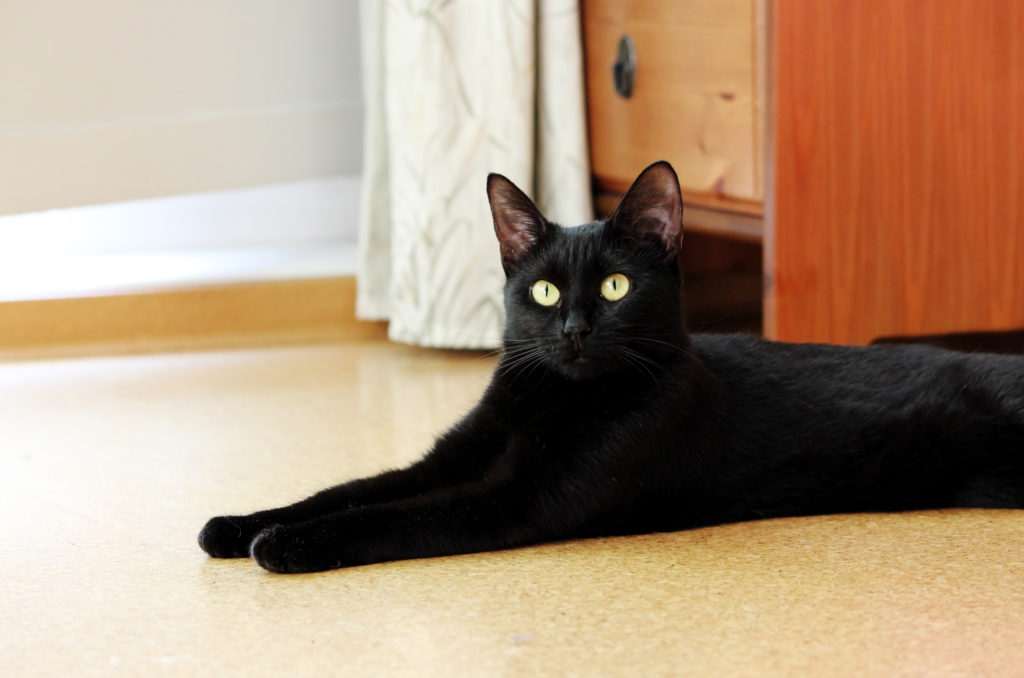
You heard us: cork!
Cork is a unique type of wood flooring. And yes, it is wood! Did you know that cork comes from cork trees? We didn’t either until we learned about cork floors.
Cork floors aren’t as hard to find as you might think. You can buy them almost anywhere you can buy floors; you can even find cork floors at Lowes (though the quality might be lacking).
But cork flooring doesn’t just look cool—it also has some unique features as well. We’d highly recommend digging into the pros and cons of cork flooring to learn more.
Why Cork Might Be the Best Flooring for Dogs
Cork flooring gives allergy sufferers great reason to celebrate: it’s antimicrobial, which means that it impedes the growth of bacteria that can cause hay fever.
It also means that cork flooring is mold and mildew-resistant. In other words, cork is excellent news for your allergies—and lousy news for mold and mildew.
Cork flooring is also very soft and comfortable on your dog’s joints and paws. It has a great bounce, which can make your dog comfortable. It’s also an excellent sound absorber, so you’ll never hear that clicking of nails.
Plus, as long as you buy some of the best cork flooring and reseal it regularly (as in, once per year or more), it’ll stay remarkably water-resistant!
How Do You Install Cork Flooring?
Cork is some of the easiest flooring to install. You can go the standard route with click-together planks, or you can purchase peel-and-stick cork tiles to slap on your floor (very similar to peel-and-stick carpet tiles). How easy is that? Check our guide on how to install carpet tiles to see just how simple.
Of course, you can also install cork from a large sheet roll, but it’s super tricky. It can be difficult to lay it perfectly straight and with no bubbles or gaping. This method is best left to a professional installer.
Why Cork Might Not Be the Best Flooring for Pets
Alas, there are some disadvantages of cork flooring.
Some cork flooring is indeed water-resistant, but none is waterproof. This spells bad news if your dog tends to use your floor as a restroom or is a sloppy drinker.
Some throw rugs with rubber backing may help but may not be a fool-proof solution.
Cork is not very scratch-resistant, either. Lighter colors can hide scratches better, but they’ll still likely be there. And because of the soft nature of cork, your furniture may leave dents behind, similar to the marks found in carpets when you move your furniture around.
However, carpet ultimately springs back. Cork doesn’t. Translation: if your dog has long nails and loves to run laps on your floors, cork might not be the best choice.
#7: Concrete—A Rugged and Modern Floor for Pets
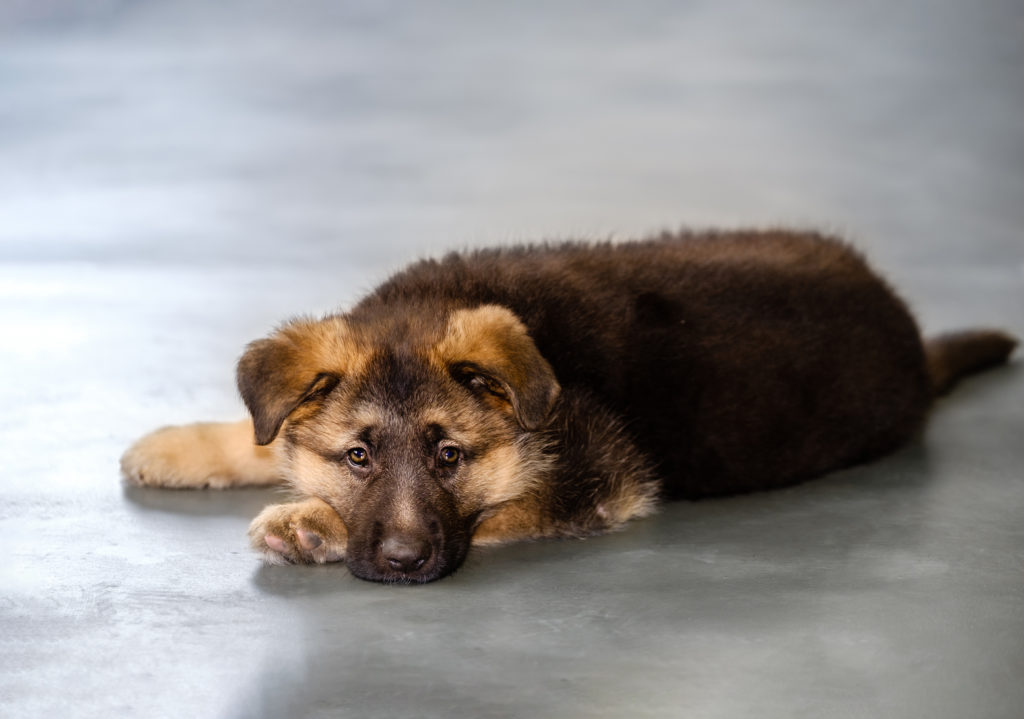
Concrete isn’t just for basements anymore! This industrial look is super hot right now, and with good reason. It’s very different from traditional flooring choices and very sleek-looking. Don’t believe us? What about concrete flooring that looks like wood? See? Super hot.
Why Concrete Might Be the Best Flooring for Dogs
It’s clear to see why concrete might be the best flooring for dogs. It’s virtually indestructible and totally waterproof! Along with tile, concrete is one of the most sturdy flooring options you can find. It can’t be scratched or dented.
And as you might suspect, concrete floors are ridiculously easy to clean. Did somebody say stains? What are those? When it comes to the best waterproof flooring for pets, you can’t do better than concrete.
Go ahead. Let your dog do their worst. They can’t damage this floor, no matter how hard they try.
How Do You Install Concrete?
Concrete isn’t exactly a DIY flooring option. Whether you’re restoring some old and damaged concrete or starting from scratch, it’s best to hire an expert. Pouring a slab of concrete is no simple task.
Why Concrete Might Not Be the Best Flooring for Pets
The downsides of concrete floors with pets fall into the “comfort” category. What makes concrete so dang impenetrable is what makes it so uncomfortable for your dogs—it’s hard. Like, really, really hard.
Concrete will not be pleasant for your dog to sleep and walk on.
Concrete is also very cold. Your pup’s paws may always be chilly walking over your concrete floor, and laying down on it can also give them a chill. A thick and cozy bed will be a must!
Least Pet-Friendly Flooring Options
Sadly, not all floors mix with pets. Here are some of the worst floors for dogs and other furry friends.
Carpet
Confession time: we love carpet. It’s soft, cozy, and comforting. Dogs agree. It just feels good.
There are several factors, however, which make carpet less than ideal for pet-owning households. For starters, carpet is a massive trap for allergens and dirt. It can even trap fleas, making them more challenging to remove.
Carpet isn’t very easy to clean, either. It can stain easily and hold smells. And while water won’t ruin your carpet itself, it will seep through and destroy your subfloor.
On notable exception to this: the machine-washable carpet tiles that Proximity Mills makes. Unlike most carpet tiles on the market, Proximity Mills tiles are held in place with their proprietary velcro-like “FriXion Pads” instead of adhesives. That makes it a cinch to take off, wash, and place back down.
Dogs and cats may not be able to scratch carpet, but they sure can tear it up. Their claws can do just as much damage to a carpeted floor as they can to a wood or cork floor.
Solid Hardwood
Solid hardwood floors may be gorgeous and long-lasting, but they are also somewhat fragile. The best hardwood floors may be durable, but they’re still susceptible to scratches from large, rambunctious dogs. Some will fare better than others, depending on their hardness level, but even solid wood from the best hardwood floor brands will suffer at the hands—er—paws of your pets.
Plus, wood flooring costs are expensive to begin with. And once you add in the cost to refinish hardwood flooring every few years to recover from scratches (as you’ll have to do if you have solid wood), you’ll find yourself spending a pretty penny.
Non-Waterproof Laminate
You caught us. We just listed laminate as some of the best flooring for dogs. What gives? We just really want to drive home the point that laminate flooring must be waterproof laminate flooring if you want it to jive with your pets.
How To Care for Your Dog-Friendly Flooring
Everybody likes a clean floor. The problem with pets is that they just don’t care. Their fur and dander shed all over the place. They also bring lots of the outside inside with them. Geesh, it’s like they think they live there or something.
- Any floor that pets come in contact with will require some extra TLC. Between shedding fur, bathroom accidents, spilled water bowls, tracked litter, and vomiting, there’s a lot to stay on top of.
- If you regularly brush your pets (or rather, if they consent to a regular brushing!), you can help cut down on the clumps of dog and cat hair that often sail by like tumbleweed. Otherwise, frequent sweeping and vacuuming is a great way to stay on top of it.
- Mop up accidents as soon as possible, using an appropriate product for your specific flooring. This will prevent any moisture damage and cut down on the likelihood of stains.
- Another way to cut down on cleaning, in the long run, is to put a mat under their food and water dish, as well as in front of their litter box. This will protect your floors from moisture, food, and litter being dragged all over the room.
- Keep nails and claws trimmed to minimize scratches. Your furniture may also end up thanking you.
Best Flooring for Pets: FAQ
You’ve got questions; we’ve got answers. We also have a cheat sheet for easy reference!
Is Laminate or Waterproof Vinyl Best for Dogs?
In the great vinyl plank vs. laminate debate, when it comes to pets, vinyl is the preferred floor. Both have wonderful pet-appropriate options and do a fantastic job of mimicking wood floor designs. The best vinyl plank flooring, however, has the upper hand with waterproofing. And the floor that can handle moisture better is the better floor for pets, if you ask us.
What is the Best Floor for Pet Accidents?
Concrete is, far and away, the best floor for pet accidents. It’s the best waterproof flooring for pets. It laughs in the face of dog and cat urine. Tile is another clear front runner, but grout can be a little cranky sometimes. Certain accidents may stain grout, which prevents it from being the number one choice.
Waterproof laminate and vinyl are two other excellent choices for flooring if your pets have the occasional accident. And, let’s be honest, it’s going to happen from time to time. So it may be best to be proactive about this issue when picking out the flooring for dogs.
Which Flooring is Easiest for Dogs to Walk on Without Slipping?
Cork is an exceptional option for preventing slips. All dogs can be prone to slipping and sliding a bit on slick floors, but it is likely to happen to them more often as they age. You can help prevent them from causing further damage to themselves with a slip-proof floor.
Bamboo and vinyl are also good skid-resistant options. Bamboo absorbs moisture, which makes the flooring easier to grip. And vinyl can come textured, which also helps a dog gain traction.
Which Type of Wood Flooring is Best for Dogs?
If real wood is the most important thing to you, then engineered wood with a thick protective finish is the best option. It will cost you extra but can save you refinishing costs in the long run.
There’s no great answer to this question. Wood and dogs simply aren’t a great combination. However, this is your best option if wood matters to you. And your resale value will thank you.
Which Wood Floor is Best for Large Dogs?
Again, we have to stick with engineered hardwood floors for large dogs. The protective finish probably won’t be quite enough to save your floor from scratches, especially if your dog is very active, but it can prevent total destruction. And the fact that it can be refinished is a lifesaver.
Don’t rule out cork, though. Remember, cork is technically a wood floor! And while it’s likely to get a bit scratched up and dented with a large dog using it, it is also less expensive than engineered hardwood if you need to replace it.
What Flooring is Waterproof AND Scratch Proof?
If you need to ensure that your flooring has all the bases covered, waterproof and scratchproof are the two most significant issues. Just as concrete and tile are the best choices for pet accidents, they are also the best for waterproof and scratch-resistant flooring.
What’s the Best Flooring to Put in a Dog Kennel?
Once again, concrete comes up best in show. A dog kennel is not a place where you are really concerned with aesthetics, so mess is likely your biggest concern. And since you aren’t likely to have furniture to worry about, either, you can just hose down the concrete flooring in your dog kennel. That’s why concrete is also the best choice for mudroom flooring.
Let’s Not Be Single-Minded: What’s the Best Flooring for Cats?
Cats aren’t all that different than dogs when it comes to your flooring needs. They may not be as likely to scratch up your floor as a large dog will, but they are just as likely to have an accident, vomit, shed, and spill water and food.
In exchange for worrying about scratch-resistant flooring, you might want to think about grooves in your flooring where litter might get stuck. Perhaps a tile floor might be a great spot to keep their litter box; it’s effortless to sweep up spilled litter, mop up any accidents that miss their target, and won’t warp if it gets wet.
Bottom Line: What is the Best Flooring for Dogs? And What’s the Best Waterproof Flooring for Pets in General?
We’ve gone over many beautiful options, and only one question remains: what flooring will be best for your home and your pets? That’s a question that only you can answer. You know your needs as far as your pet and your priority for how your floor looks.
Fortunately, we’ve now armed you with excellent information that can help you narrow down your options. Isn’t it nice to have options? And if you still need some guidance, get in touch with a flooring store near you for help!
Either way, thanks so much for reading, and good luck on your flooring search!
For more resources, check out:
- Engineered Hardwood vs. Laminate: Side-by-Side Comparison
- 15 Beautiful and Affordable Outdoor Flooring Options
- Can You Bleach Wooden Floors? Yes! Here’s How.
- Wood Floor Bathrooms (& How to Do Them Right)
- Your Definitive Guide to Ash Flooring
- Advantages & Disadvantages of Hickory vs. Oak Flooring
- Hickory Flooring Pros and Cons: The Guide
- Sustainable Wood Flooring: 11 Great Options & More
- The Ultimate Guide to Low-VOC Flooring
- Wide Plank Wood Flooring 101: The Total Guide
- LifeProof Vinyl Flooring Reviews: Is It Worth It?
- SmartCore Flooring Reviews: Is it Worth it?
About The Author

Courtney Daily
September 17, 2021
Courtney is a freelance writer who wears many other hats: kindergarten teacher by day, Broadway diva in the shower. She is a transplant Hoosier who originated in New England. When she isn't writing in her spare time, you will find her reading history books, arguing with her latest knitting project, or being beaten by her kids at most games.
